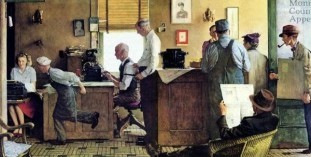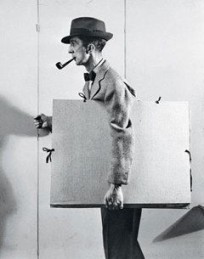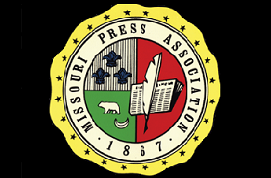From the desk of John Hughes, President of the National Press Club
The boards of the National Press Club and non-profit National Press Club Journalism Institute voted last night to sell our Norman Rockwell painting, “Norman Rockwell Visits a Country Editor.”
 The sale will occur at an auction at Christie’s on Nov. 19. Christie’s expects the artwork to sell for $10 million to $15 million. Seventy percent of the proceeds will go to the Club, 30 percent to the Institute.
The sale will occur at an auction at Christie’s on Nov. 19. Christie’s expects the artwork to sell for $10 million to $15 million. Seventy percent of the proceeds will go to the Club, 30 percent to the Institute.
This is wonderful news for the Club and the Institute because we will have additional resources to carry out our missions for many years to come. However, this news may come as a surprise to many of you. You may wonder, are the Club and Institute broke, or desperate for cash, so that they had to look around the Club to look for assets to sell? No, that is far from the case. Then what is going on? How did we get to this point?
I will talk more at this morning’s General Membership Meeting at 9am at the Club. If you can’t be there in person, tune in to the webcast of the event on our website. For those of you who can’t attend or tune in, let me explain more.
First, a little information about the painting is in order. It appeared in the Saturday Evening Post on May 25, 1946. We don’t know exactly when it arrived, but our Club newsletter in 1962 and 1963 makes reference to a “gift of the Saturday Evening Post.” When Rockwell himself spoke at the Club in 1967, the moderator of the event made reference to the painting.
For years the artwork hung outside the Club’s members-only bar/restaurant on the 14th floor, the Reliable Source. In 1998, the Club transferred the painting and all of the Club’s artwork to the Institute. And for much of the past six years, the painting hasn’t been at the Club at all – it’s been under the care of the Rockwell Museum in Stockbridge, Massachusetts.
Anyone who owns a stock portfolio knows that market fluctuations bring about unanticipated changes. The same is true for art. The Club and Institute routinely had the Rockwell appraised over the years for insurance purposes. The art always had strong financial value, which remained relatively consistent from year to year. Then in 2014, the appraised value increased exponentially.
At the time that appraisal came to us last year, the artwork happened to still be hanging outside the Reliable Source. Both boards promptly took action for the safety of the piece. We sent it back up to the Rockwell Museum. The appraisal, in a resounding way, delivered the message that had been in the backs of our minds for years – that the Club and Institute simply lacked adequate security to protect such a valuable piece of art. We knew it would be safe at the museum.
Once we knew the painting was safe, the question then became, now what? The Club and Institute boards formed a task force last spring made up of three members from each board. The group met with art, insurance, law and other experts to begin to answer the question as to what should happen next.
One thing quickly became clear. It wouldn’t be wise to bring such a valuable piece of art back to the Club. Our Clubhouse is not a high-security museum. Hundreds of thousands of people come through our premises each year. Hiring security guards, as a museum would do, would cost the Club more than six figures annually. A one-time physical security upgrade – cameras, lights, sensors, glass – would cost an additional six-figures. Insurance costs would hit six figures after a little more than two years. That is a lot of figures!
As I said earlier, the Club and Institute are not desperate for money. Our finances are strong, with our reserve at its highest in decades. The Club has been profitable for seven years in a row while the journalism industry struggles.
However, our board members determined that over time, the costs of securing such a valuable artifact would be a drain on the financial resources of the Club and the Institute. The Club is the world’s leading professional organization for journalists. It didn’t make sense for us to begin diverting so many of our resources for art security.
We received some good news early on in the process. We learned we could have a highly precise replica of the Rockwell made that could hang in its usual place outside the Reliable Source and be enjoyed by Press Club members for generations to come. We could even put the replica in its original frame! To the naked eye, this replica would look just like our original Rockwell. The replica would allow the Club to honor and celebrate its history without incurring considerable new costs or putting its assets at risk.
The question then became, what to do with the original? We could keep it at a museum for years and years. We could wait for the painting’s value to drop to the point where we would be comfortable bringing it back to the Club without paying for extra security. We could conduct a multi-million dollar fund-raising campaign to pay for security. We could put the painting in a vault and wait for the value to appreciate even more.
The task force came to the conclusion that a sale is best. For one, task force members learned the art market is volatile. There is no guarantee the painting would continue appreciating in the future. Also, the painting at its newly appraised value had become the Club’s and the Institute’s most valuable asset – by far. It didn’t make sense to us to have such a large share of our assets tied up in a single item.
What about donating the artwork to a museum? As financial stewards of the Club and Institute, we didn’t think that was the responsible thing to do for our members and donors. A fundraising campaign for art security seemed unrealistic and far removed from our mission.
In a sale, we secure the Club’s future and help prepare for the day when the subsidized rent we have enjoyed for decades goes away. We are in a better position to care for our facility, offer world-class programs and support and grow our membership.
The Institute, with its share of the proceeds, expands its ability to carry out its vital mission for journalists. The needs of the profession are immense – from training those who have lost jobs to fighting for a free press worldwide.
The sale of the painting of a small-town America newsroom in the 20th Century will sustain our missions to support journalism for many decades to come in the 21st Century. What a great legacy for Norman Rockwell.


